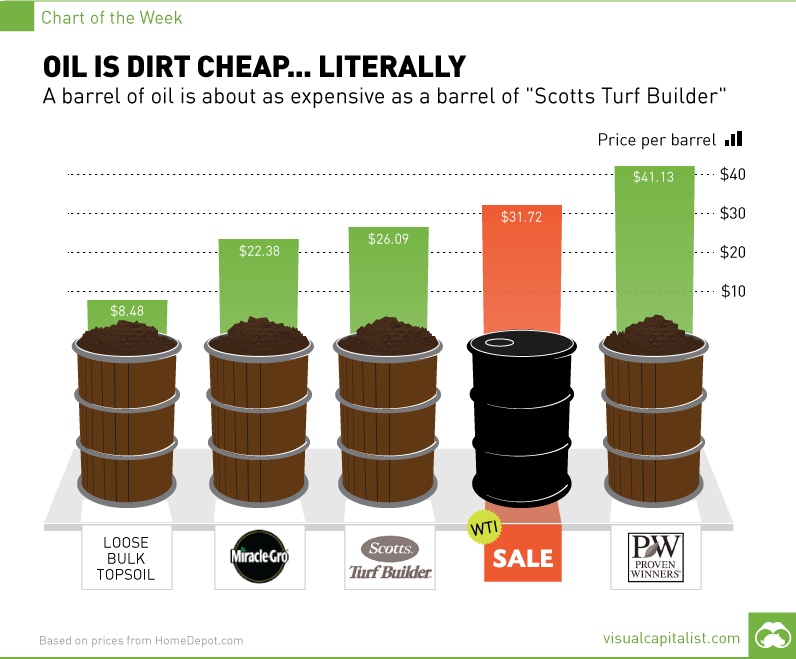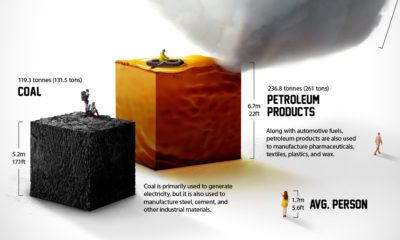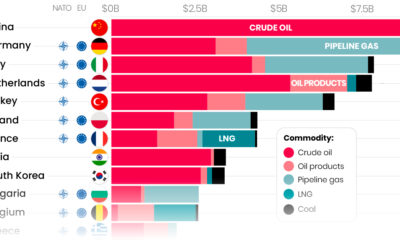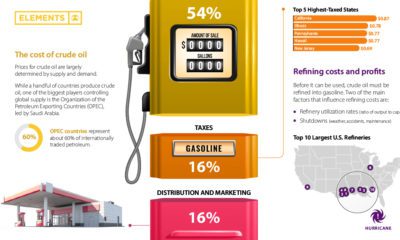Oil is Dirt Cheap… Literally [Chart]
A barrel of oil is the same price as a barrel of “Scott’s Turf Builder”
The Chart of the Week is a weekly Visual Capitalist feature on Fridays. In theory, a barrel of crude oil seems quite valuable. It’s well-known, for example, that from one barrel of oil, a refinery can make 19 gallons of gasoline, 12 gallons of diesel, and four gallons of jet fuel. That’s the equivalent of six billion joules of energy, or enough to power the average U.S. household for 1.8 months.
A Dirt Cheap Experiment
However, sometimes the laws of supply and demand work in mysterious ways. While it seems like oil has good intrinsic value, the glut of supply available to the market is so great that “black gold” has become very cheap. Some would even say “dirt cheap”. As a part of our landmark investigation, we went all the way to the Home Depot’s website to verify if this were actually true. The results were astonishing, and this information will definitely be helpful the next time I need to do some gardening. We started by going for the bulk stuff. For only $135, it’s possible to buy 5 cubic yards of loose bulk top soil. That’s enough for 24 barrels worth, which seemed like a steal. The only downside was that it cost an extra $69 to schedule a dump truck to come by our house, which made it likely overkill for this experiment. Next, we checked out a bag of Miracle Gro. It’s got the brand name reputation, and this particular bag had a user rating of four stars. At $7.97 for a two cubic feet, we’d just need just less than three bags to fill up a barrel. That works out to $22.38 a barrel. Not bad. However, if we’re going to be serious about our dirt, we’re going to need something that promotes a strong root system and creates a prime seed-growing environment. We took a peek at Scotts Turf Builder, which is only $6.97 per bag. However, with only 1.5 cubic feet per bag, it’s going to take up over 3.7 to fill up our barrel, bringing our total cost to $26.09. We’re now within $1.50 of oil’s 52-week low of $27.56.
The Winner
As we continued to shop online for dirt, a five-star gem caught our eye. The brand name was Proven Winners. How could we go wrong with that? We took a look at the user reviews to be sure. “I have a high-quality soil-test kit and tested this soil. It is very high in nitrogen, potassium, and phosphorus, so though it will be excellent for plants it is NOT a soil for starting seeds or potting up seedlings,” wrote a previous buyer. Noted. We will not use it for starting seeds or potting up seedlings. We checked out the price, and for $10.99 per bag containing 1.5 cubic feet, we had our winner. It takes 3.7 of these to fill up our barrel, bringing our cost per barrel of this particularly good dirt to $41.13. Unfortunately that’s about $10 more than a barrel of oil, but I guess we’ll hedge our bets. on Even while political regimes across these countries have changed over time, they’ve largely followed a few different types of governance. Today, every country can ultimately be classified into just nine broad forms of government systems. This map by Truman Du uses information from Wikipedia to map the government systems that rule the world today.
Countries By Type of Government
It’s important to note that this map charts government systems according to each country’s legal framework. Many countries have constitutions stating their de jure or legally recognized system of government, but their de facto or realized form of governance may be quite different. Here is a list of the stated government system of UN member states and observers as of January 2023: Let’s take a closer look at some of these systems.
Monarchies
Brought back into the spotlight after the death of Queen Elizabeth II of England in September 2022, this form of government has a single ruler. They carry titles from king and queen to sultan or emperor, and their government systems can be further divided into three modern types: constitutional, semi-constitutional, and absolute. A constitutional monarchy sees the monarch act as head of state within the parameters of a constitution, giving them little to no real power. For example, King Charles III is the head of 15 Commonwealth nations including Canada and Australia. However, each has their own head of government. On the other hand, a semi-constitutional monarchy lets the monarch or ruling royal family retain substantial political powers, as is the case in Jordan and Morocco. However, their monarchs still rule the country according to a democratic constitution and in concert with other institutions. Finally, an absolute monarchy is most like the monarchies of old, where the ruler has full power over governance, with modern examples including Saudi Arabia and Vatican City.
Republics
Unlike monarchies, the people hold the power in a republic government system, directly electing representatives to form government. Again, there are multiple types of modern republic governments: presidential, semi-presidential, and parliamentary. The presidential republic could be considered a direct progression from monarchies. This system has a strong and independent chief executive with extensive powers when it comes to domestic affairs and foreign policy. An example of this is the United States, where the President is both the head of state and the head of government. In a semi-presidential republic, the president is the head of state and has some executive powers that are independent of the legislature. However, the prime minister (or chancellor or equivalent title) is the head of government, responsible to the legislature along with the cabinet. Russia is a classic example of this type of government. The last type of republic system is parliamentary. In this system, the president is a figurehead, while the head of government holds real power and is validated by and accountable to the parliament. This type of system can be seen in Germany, Italy, and India and is akin to constitutional monarchies. It’s also important to point out that some parliamentary republic systems operate slightly differently. For example in South Africa, the president is both the head of state and government, but is elected directly by the legislature. This leaves them (and their ministries) potentially subject to parliamentary confidence.
One-Party State
Many of the systems above involve multiple political parties vying to rule and govern their respective countries. In a one-party state, also called a single-party state or single-party system, only one political party has the right to form government. All other political parties are either outlawed or only allowed limited participation in elections. In this system, a country’s head of state and head of government can be executive or ceremonial but political power is constitutionally linked to a single political movement. China is the most well-known example of this government system, with the General Secretary of the Communist Party of China ruling as the de facto leader since 1989.
Provisional
The final form of government is a provisional government formed as an interim or transitional government. In this system, an emergency governmental body is created to manage political transitions after the collapse of a government, or when a new state is formed. Often these evolve into fully constitutionalized systems, but sometimes they hold power for longer than expected. Some examples of countries that are considered provisional include Libya, Burkina Faso, and Chad.














